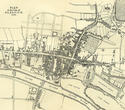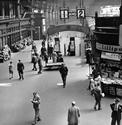 The opening of the Royal Exchange in 1829/30 and the Corn Exchange in 1843 ushered in a new era of confidence to Glasgow. The city continued to march westward and there was stiff competition for the best sites to the west of Union Street. Grahamston began to change rapidly. An 1853 panorama of Glasgow shows Grahamston to be a bustling place with many businesses and tenement houses. St Columba's Gaelic Church is prominent and there is a tall chimney belching black smoke.
The opening of the Royal Exchange in 1829/30 and the Corn Exchange in 1843 ushered in a new era of confidence to Glasgow. The city continued to march westward and there was stiff competition for the best sites to the west of Union Street. Grahamston began to change rapidly. An 1853 panorama of Glasgow shows Grahamston to be a bustling place with many businesses and tenement houses. St Columba's Gaelic Church is prominent and there is a tall chimney belching black smoke.
 The 1871 Glasgow Post Office Directory lists nearly 300 businesses in Grahamston including the offices of the Calcutta Line, the Bombay Line and numerous shipbrokers. There were merchants, agents, tobacconists, chemists, writers, brass-founders, tailors, ironmongers, public houses and distillers catering to the needs of local people and travellers. Gone were the market gardens and the only remaining echoes of Grahamston's rural past were the numerous corn factors and grain merchants, mainly located in Hope Street and Alston Street.
The 1871 Glasgow Post Office Directory lists nearly 300 businesses in Grahamston including the offices of the Calcutta Line, the Bombay Line and numerous shipbrokers. There were merchants, agents, tobacconists, chemists, writers, brass-founders, tailors, ironmongers, public houses and distillers catering to the needs of local people and travellers. Gone were the market gardens and the only remaining echoes of Grahamston's rural past were the numerous corn factors and grain merchants, mainly located in Hope Street and Alston Street.
 By the end of that decade Grahamston was to change even more dramatically. On 1 August 1879 the Caledonian Railway Company opened Central Station at its new terminus on the north side of the River Clyde. (Its services had previously terminated at Bridge Street Station on the south side.) About seventy-five per cent of Grahamston was demolished to make way for the station although the west side, including St Columba's Church, was untouched. This was a temporary reprieve because the station had to be extended twenty years later necessitating the demolition of the surviving Grahamston area. Grahamston had been obliterated except for two buildings, known as the Grant Arms and the Duncan's Hotel building, which survive to this day.
By the end of that decade Grahamston was to change even more dramatically. On 1 August 1879 the Caledonian Railway Company opened Central Station at its new terminus on the north side of the River Clyde. (Its services had previously terminated at Bridge Street Station on the south side.) About seventy-five per cent of Grahamston was demolished to make way for the station although the west side, including St Columba's Church, was untouched. This was a temporary reprieve because the station had to be extended twenty years later necessitating the demolition of the surviving Grahamston area. Grahamston had been obliterated except for two buildings, known as the Grant Arms and the Duncan's Hotel building, which survive to this day.